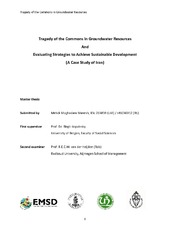| dc.description.abstract | At present, many countries (including Iran) face "extremely high" levels of water stress, which means more than 80 percent of the water available to agricultural, domesc, and industrial users is withdrawn from groundwater resources annually. Based on the stascs, the agriculture sector is responsible for consuming more than 90 percent of water in Iran. To date, the growing demand for water in the agriculture sector has largely been met by mining fossil groundwater resources. Indeed, about 90 percent of groundwater use belongs to the agriculture sector. Needless to say, this unsustainable trend cannot continue for a long time since groundwater resources are limited in practice. So, decision‐makers need doing some urgent, effective actions to handle this problem. The main objective of this study is understanding the underlying cause of the problem and evaluating usually suggested policies to address the crisis. The SD methodology is used. the model is based on “tragedy of the commons” theory and tries to explain how farms attempt to maximize their profits turns to a serious threat for the sustainability of groundwater resources. In the following, the model has been used to evaluate various strategies for avoiding the depletion of groundwater resources. For this purpose, “gap analysis” has been used. In gap analysis, the future under the present strategy is forecasted. Then, objectives or desired future is identified and the gap between the objectives and the future conditions under the current strategy is determined. Finally, new strategies which will help to close the gap will be designed. In the end, it is concluded that; (1) the government should consider the concept of maximum sustainable yield (MSY) and control the size of irrigated land, share of high‐water demand crops, and number of wells (2) improving irrigaon efficiency and many other policies are fruitless if the government do not consider the rebound effect and combined policies should be adopted (3) even by changing the water governance to eliminate the tragedy of the commons, overshoot and collapse can happen due to misperception. | en_US |
